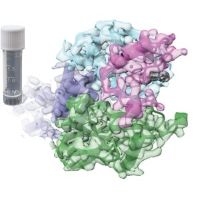Specification
| Uniprot ID | P78356 |
| Gene Names | PIP4K2B |
| Alternative Names | (1-phosphatidylinositol 5-phosphate 4-kinase 2-beta)(Diphosphoinositide kinase 2-beta)(Phosphatidylinositol 5-phosphate 4-kinase type II beta)(PI(5)P 4-kinase type II beta)(PIP4KII-beta)(PtdIns(5)P-4-kinase isoform 2-beta) |
| Organism | Homo sapiens (Human) |
| Expression Host | E.coli |
| Tag Info | N-terminal 10xHis-tagged |
| Molecular Weight | 53.3 kDa |
| Expression Region | Full Length of Mature Protein(2-416aa ) |
| Expression Region | N-terminal 10xHis-tagged(Full Length of Mature Protein ) |
| Purity | Greater than 90% as determined by SDS-PAGE. |
| Endotoxin | Not test. |
| Form | Liquid or Lyophilized powder |
| Buffer | The default storage buffer is Tris/PBS-based buffer, 5%-50% glycerol if the delivery form is liquid. The lyophilization buffer is Tris/PBS-based buffer, 6% Trehalose, pH 8.0 if the delivery form is lyophilized powder. Please contact us if you have any special requirment. |
| Reconstitution | Please reconstitute protein in deionized sterile water and we recommend that briefly centrifuge thevial prior to opening the vial .We recommend aliquot for long-term storage at -20℃/-80℃. |
| Storage | Generally, the shelf life of liquid form is 6 months at -20℃/-80℃. The shelf life of lyophilized form is 12 months at -20℃/-80℃. The shelf life is related to many factors, storage state, buffer ingredients, storage temperature and the stability of the protein itself. |
| Protein Sequence | SSNCTSTTAVAVAPLSASKTKTKKKHFVCQKVKLFRASEPILSVLMWGVNHTINELSNVPVPVMLMPDDFKAYSKIKVDNHLFNKENLPSRFKFKEYCPMVFRNLRERFGIDDQDYQNSVTRSAPINSDSQGRCGTRFLTTYDRRFVIKTVSSEDVAEMHNILKKYHQFIVECHGNTLLPQFLGMYRLTVDGVETYMVVTRNVFSHRLTVHRKYDLKGSTVAREASDKEKAKDLPTFKDNDFLNEGQKLHVGEESKKNFLEKLKRDVEFLAQLKIMDYSLLVGIHDVDRAEQEEMEVEERAEDEECENDGVGGNLLCSYGTPPDSPGNLLSFPRFFGPGEFDPSVDVYAMKSHESSPKKEVYFMAIIDILTPYDTKKKAAHAAKTVKHGAGAEISTVNPEQYSKRFNEFMSNILT |
Background
| Research Areas | Signal Transduction |
| Relevance | Participates in the biosynthesis of phosphatidylinositol 4,5-bisphosphate . Preferentially utilizes GTP, rather than ATP, for PI(5)P phosphorylation and its activity reflects changes in direct proportion to the physiological GTP concentration . Its GTP-sensing activity is critical for metabolic adaptation . PIP4Ks negatively regulate insulin signaling through a catalytic-independent mechanism. They interact with PIP5Ks and suppress PIP5K-mediated PtdIns(4,5)P2 synthesis and insulin-dependent conversion to PtdIns(3,4,5)P3 . |
QC Data
| Note | Please contact us for QC Data |
| Product Image (Reference Only) |  |

